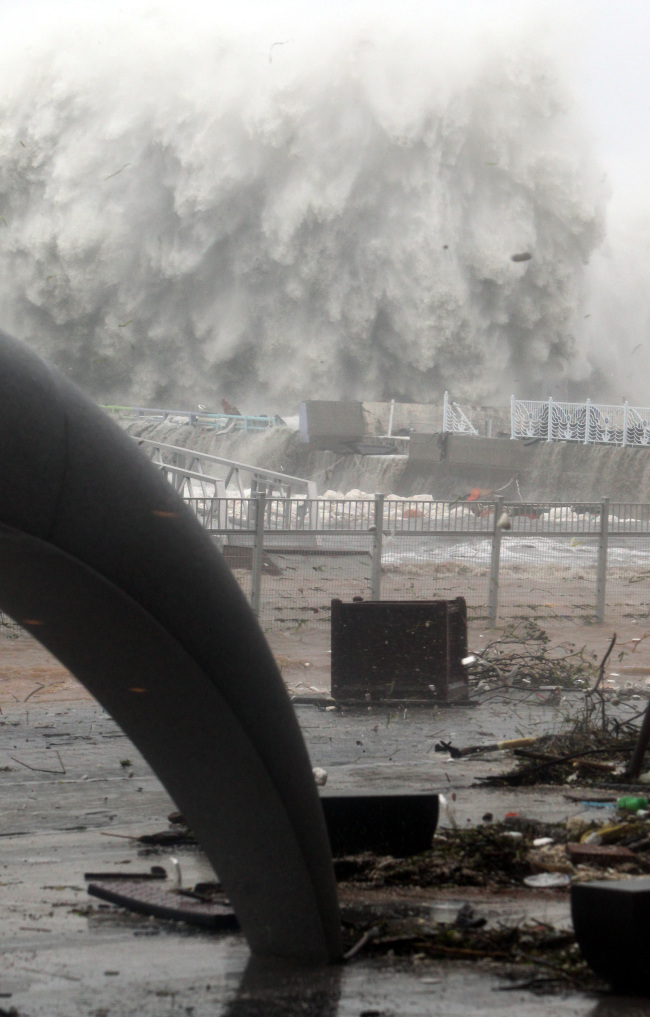
Typhoon Sanba slammed southern regions of Korea on Monday, causing massive power outages, submerging roads and houses and destroying farmland just ahead of harvest time. At least one was killed and several others injured.
The third storm to strike the country in three weeks left a trail of destruction in the provinces of Jeju, Jeolla and Gyeongsang, already battered by two powerful typhoons late last month.
A 53-year-old woman died in a landslide in Sangju, North Gyeongsang Province, where the typhoon made landfall at around 11:30 a.m. on Monday with heavy downpours and strong winds.
As of 5 p.m., hundreds of homes were submerged or buried by landslides elsewhere, but no further deaths were reported, the National Emergency Management Agency said. Several sustained injuries, mostly from flying objects, it said.
Flood alerts were issued for neighboring areas of the lower Nakdong River, which runs through Busan and Gyeongsang provinces, and smaller Hyeongsang River in Pohang, North Gyeongsang Province.
The typhoon, the 16th of the season, was plowing northeastward at a speed of 34 kilometers per hour and was expected to exit through the East Sea at around 7 p.m., according to the Korean Meteorological Administration.
“Though slightly weakened, Sanba is still a strong typhoon, with central pressure of around 980 hPa and wind speeds of up to 38 meters per second,” the KMA said.
The authority issued typhoon advisories for most parts of the country, including Seoul, warning of total rainfalls of up to 300 millimeters.
The southern island of Jeju, which was the landing spot of Typhoon Bolaven which struck the country at the end of August, was again the main target of Sanba’s fury early Monday. Mount Halla on the island received about 583 millimeters over the weekend. All schools on the island were ordered closed on Monday.
Nationwide, all domestic flights and ferry services were suspended.
Some 70 international flights departing from Gimhae and Incheon airports were canceled.
Major dams such as Paldang, Chungju and Namgang discharged water to control their water levels. National parks were declared off-limits as a precautionary measure, while major bridges and tunnels were closed to traffic. More than 450,000 households lost power.
President Lee Myung-bak, meeting officials at the national disaster control headquarters, directed an all-out effort to help minimize damage and recover from the typhoon’s aftermath.
“The typhoon is expected to pass inland past farming regions. We have to make thorough preparations to minimize damage to farm produce ahead of Chuseok,” Lee said. Chuseok, one of Korea’s two biggest holidays, begins on Sept. 30 this year. “Military and all other available resources should be deployed for preparation and recovery efforts.”
Sanba came on the heels of two strong typhoons, Bolaven and Tenbin, which killed more than 20 people in southern regions.
By Lee Sun-young (milaya@heraldcorp.com)
The third storm to strike the country in three weeks left a trail of destruction in the provinces of Jeju, Jeolla and Gyeongsang, already battered by two powerful typhoons late last month.
A 53-year-old woman died in a landslide in Sangju, North Gyeongsang Province, where the typhoon made landfall at around 11:30 a.m. on Monday with heavy downpours and strong winds.
As of 5 p.m., hundreds of homes were submerged or buried by landslides elsewhere, but no further deaths were reported, the National Emergency Management Agency said. Several sustained injuries, mostly from flying objects, it said.
Flood alerts were issued for neighboring areas of the lower Nakdong River, which runs through Busan and Gyeongsang provinces, and smaller Hyeongsang River in Pohang, North Gyeongsang Province.
The typhoon, the 16th of the season, was plowing northeastward at a speed of 34 kilometers per hour and was expected to exit through the East Sea at around 7 p.m., according to the Korean Meteorological Administration.
“Though slightly weakened, Sanba is still a strong typhoon, with central pressure of around 980 hPa and wind speeds of up to 38 meters per second,” the KMA said.
The authority issued typhoon advisories for most parts of the country, including Seoul, warning of total rainfalls of up to 300 millimeters.
The southern island of Jeju, which was the landing spot of Typhoon Bolaven which struck the country at the end of August, was again the main target of Sanba’s fury early Monday. Mount Halla on the island received about 583 millimeters over the weekend. All schools on the island were ordered closed on Monday.
Nationwide, all domestic flights and ferry services were suspended.
Some 70 international flights departing from Gimhae and Incheon airports were canceled.
Major dams such as Paldang, Chungju and Namgang discharged water to control their water levels. National parks were declared off-limits as a precautionary measure, while major bridges and tunnels were closed to traffic. More than 450,000 households lost power.
President Lee Myung-bak, meeting officials at the national disaster control headquarters, directed an all-out effort to help minimize damage and recover from the typhoon’s aftermath.
“The typhoon is expected to pass inland past farming regions. We have to make thorough preparations to minimize damage to farm produce ahead of Chuseok,” Lee said. Chuseok, one of Korea’s two biggest holidays, begins on Sept. 30 this year. “Military and all other available resources should be deployed for preparation and recovery efforts.”
Sanba came on the heels of two strong typhoons, Bolaven and Tenbin, which killed more than 20 people in southern regions.
By Lee Sun-young (milaya@heraldcorp.com)
-
Articles by Korea Herald







![[KH Explains] How should Korea adjust its trade defenses against Chinese EVs?](http://res.heraldm.com/phpwas/restmb_idxmake.php?idx=644&simg=/content/image/2024/04/15/20240415050562_0.jpg&u=20240415144419)











![[Today’s K-pop] Stray Kids to return soon: report](http://res.heraldm.com/phpwas/restmb_idxmake.php?idx=642&simg=/content/image/2024/04/16/20240416050713_0.jpg&u=)